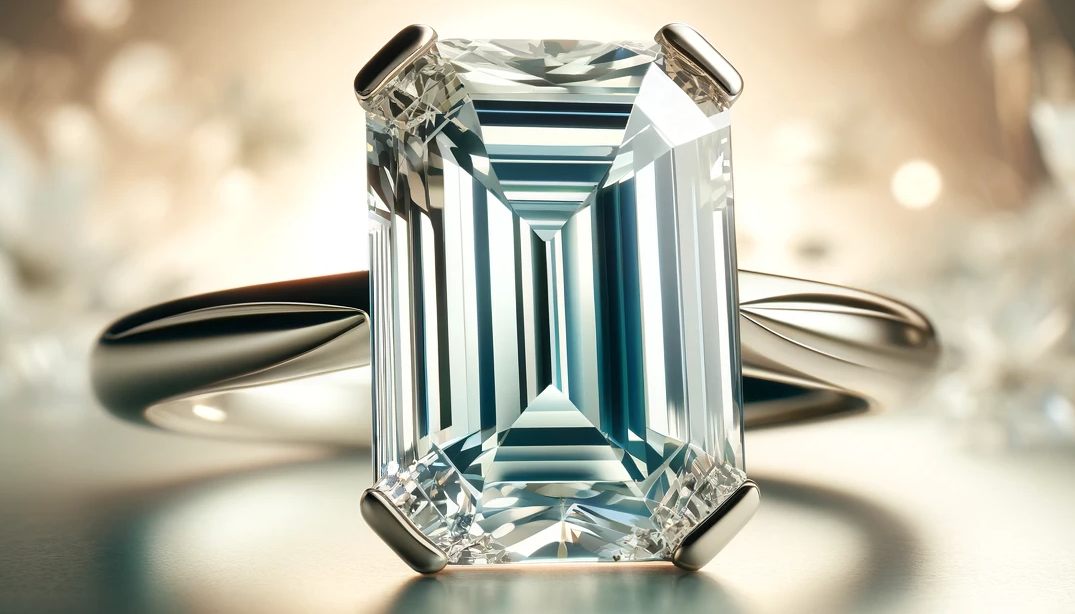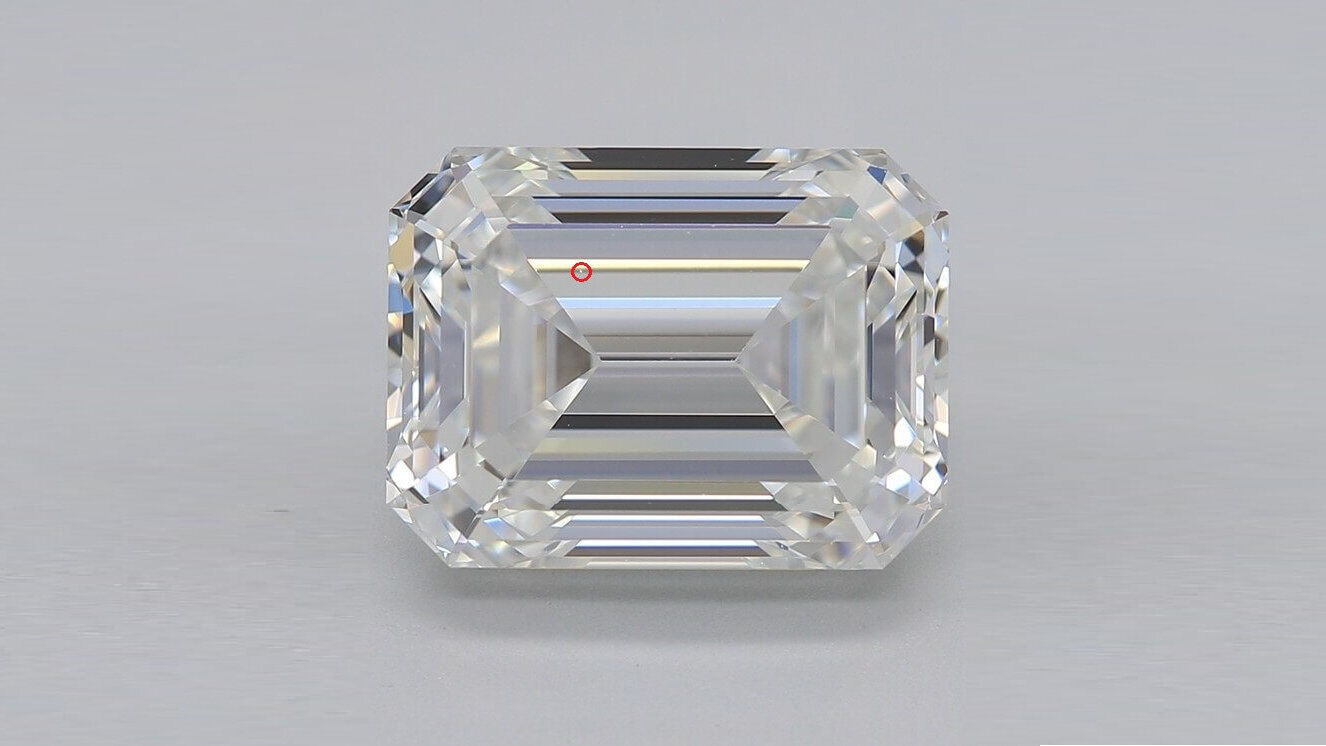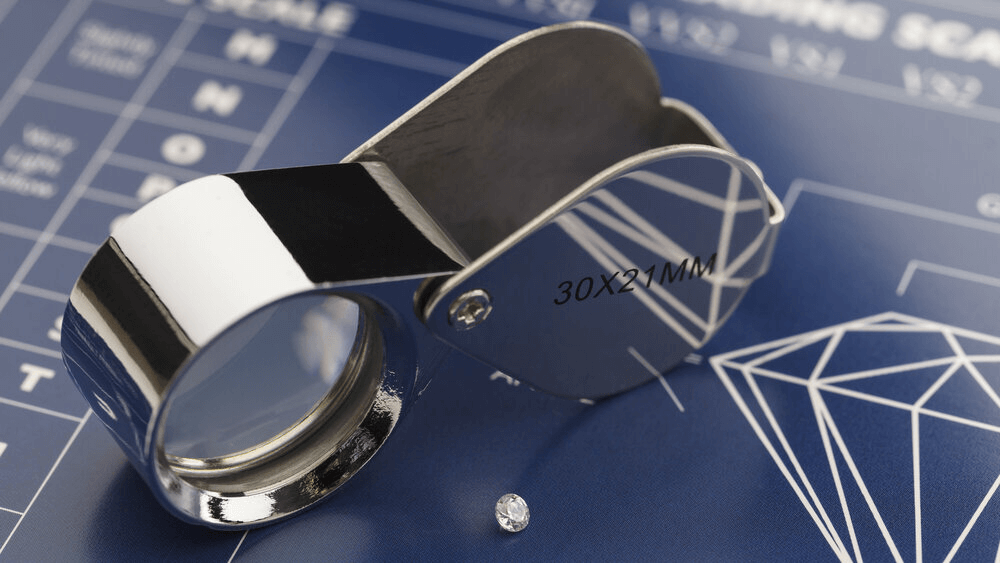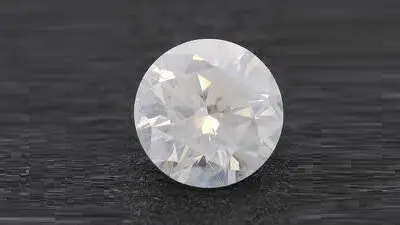The Ultimate Guide To VVS1 Diamonds

By Gary A.

Edited by Olivia H.
Published Jul 18, 2022
Edited on Dec 17, 2024
VVS1 diamonds offer unparalleled clarity, making them a top choice for those who want a near-flawless engagement ring that shines with precision. Dive into our guide and explore why VVS1 clarity stands out in the world of diamonds!

Navigate This Guide:
- 7 Quick Tips for Buying a Diamond Engagement Ring: Examining VVS1 Clarity
- Introduction
- The Basics of VVS1 Clarity
- Common Misconceptions About VVS1 Diamonds
- Price Dynamics of VVS1 Diamonds
- Color and Quality in VVS1 Diamonds
- Eye-Clean Alternatives to VVS1
- Our Expert Take
- 10 FAQs
Before we dive deeper into the specifics, here are some practical tips to help guide your decision-making process:
7 Quick Tips for Buying a Diamond Engagement Ring: Examining VVS1 Clarity
- Tip 1: Understanding the VVS1 Clarity Grade: VVS1, or ‘Very Very Slightly Included 1’, indicates minimal inclusions that are challenging to spot even under 10x magnification. Understanding this clarity grade helps in setting realistic expectations.
- Tip 2: Balancing the 4Cs with Budget: While focusing on VVS1 diamond clarity, don’t overlook the other Cs – Cut, Color, and Carat. A well-balanced diamond in all aspects often provides better value and appearance than one excelling only in clarity.
- Tip 3: Examining the Diamond Under Magnification: When examining a VVS1 diamond, utilize magnification tools to inspect for inclusions. While these imperfections are minor, it’s crucial to ensure they don’t impact the diamond’s overall appearance.
- Tip 4: Comparing VVS1 with Other Clarity Grades: Compare VVS1 diamonds with those of slightly lower clarity grades (like VS1 or VS2). This comparison can sometimes reveal that the visual differences are minimal, guiding you towards a more budget-friendly choice.
- Tip 5: Assessing Diamond Shape and Clarity: Different diamond shapes can emphasize or obscure clarity characteristics. For example, round diamonds are more forgiving of inclusions, while shapes like emerald or asscher might require higher clarity due to their open facets.
- Tip 6: Paying Attention to Diamond Color: A higher color grade (closer to D) can enhance the perceived clarity of a VVS1 diamond. Conversely, lower color grades might diminish its visual appeal, even with high clarity.
- Tip 7: Understanding Pricing and Value: VVS1 diamonds command a premium price due to their high clarity. However, the price difference between VVS1 and slightly lower grades can be substantial, without a corresponding visible difference in clarity to the unaided eye.
Now that you’ve got these practical tips, use Jeweler AI below to find the perfect engagement ring that suits your style and budget:
Introduction
On the surface of things, VVS1 diamonds look like the ideal choice for anyone with a healthy budget, and a commitment to tracking down the very best diamond money can buy for their future bride.
And why not? They represent a premium clarity grade, without forcing you to stray unnecessarily into the very expensive waters of FL and IF Diamonds. By now, you probably know full well that, to the naked eye, there is no difference between FL and VVS diamonds, so why not take this route and invest in a high quality VVS diamond?
Then again, it’s just as likely that you’ve landed on this page by chance, and still have no idea what a VVS diamond even is – although, already, you’ve probably gathered that they’re high quality. So, should you aspire to invest in a VVS diamond ring? Maybe not…

The Basics of VVS1 Clarity
VVS1 is a clarity grade, meaning ‘Very Very Slight Inclusions 1’. It is the first grade to follow from Internally Flawless, meaning that it is the third highest grade on the entire GIA Clarity Scale.
More technically, a grade of VVS means that any inclusions are visible only under 10x magnification and that even a skilled diamond grader will struggle to see them.
In other words, the diamond’s flaws are so minor that they barely impact its appearance under magnification – and, as a result, have no impact on the appearance of the diamond outside of the grader’s lab.
Definition and Characteristics
VVS1 diamonds represent an exceptionally high quality.
What’s more, given the rarity (and steep price) of FL and IF diamonds, VVS1 diamonds represent the very pinnacle of what most buyers could feasibly attain – although, of course, they really don’t need to go that far.
Comparison with FL and Other Clarity Grades
FL and IF diamonds are technically flawless. Under a microscope, diamond graders have found no noticeable inclusions or flaws. This is incredibly rare and very valuable to the right person. VVS1 is the highest clarity grade after FL and IF, meaning graders have found only the most minor inclusions when studying the diamond under a microscope.
VVS1 are much more reasonably priced than FL and IF diamonds, although all three of these clarity grades are much higher on the scale than the average shopper needs to go.
VS1 is two grades higher than VS1 on the GIA Clarity Scale and indicates that a diamond features fewer noticeable inclusions under 10x magnification than VS1.
It’s easy enough to get tripped up by these similar abbreviations in the beginning, but it is useful for you to get your head around the differences between a VVS diamond and a VS diamond.
The most significant difference between these two grades is cost. A one carat VVS1 diamond could cost $1,000+ more than a one carat VS1 diamond with a comparable cut and color, and the difference could grow more significant with the sizes of the diamonds in question.
Under the microscope, the difference remains pretty marginal. VS1 diamonds are still eye clean, and can still be a little tricky for graders to spot. As a result, the naked eye can detect no difference between these two grades.
SI1 and SI2 diamonds are also often eye clean, although under the microscope they hold much more significant inclusions.
Finally, I1 and I2 diamonds are the furthest from the VVS1 grade. They tend to be visibly included, and much cheaper as a result.

Common Misconceptions About VVS1 Diamonds
Myth 1: VVS1 Diamonds Sparkle More
A lot of first-time buyers assume that, because VVS1 diamonds are so close to flawless, they sparkle more than other diamonds placed further down the clarity grade scale.
If you got together a handful of guys currently shopping for their engagement ring and asked what their priorities were, then sparkle would no doubt sit pretty high on that list – if not at the very top. After all, before her eyes are able to take in the all-round beauty of your chosen ring, they’re going to be dazzled by an explosion of brilliance and fire – or so you’re hoping.
Clarity vs. Sparkle: The Real Influencer
Let’s get one thing straight. Cut determines sparkle more than any other factor. Light needs to rebound throughout the diamond and across its many facets in order to generate that coveted sparkle we all want to find.
This is why round cut diamonds sparkle differently to emerald cut diamonds, for instance: the designs of their facets are basically polar opposites to one another.
Clarity, on the other hand, matters very little – and not until you get so far down the scale that you’re looking at a diamond with obvious inclusions large enough to be seen clearly without any magnification equipment or specialist knowledge. In diamonds of this quality, inclusions can prevent light from traveling through the diamond as it needs to in order to generate the best sparkle, but you run no risk of that if you stick to the eye clean grades.
Myth 2: VVS1 Diamonds Are Clearer
Clear diamonds can take on a yellow hue during their development deep underground – something that is, for obvious reasons, considered a definite deal breaker for the majority of people purchasing diamonds for jewelry.
And, while discoloration is considered a flaw in clear diamonds, it is not accounted for by the clarity grade, which refers only to inclusions.
You can still find VVS1 diamonds with very poor color grades, just as you can find D or E color diamonds with pretty obvious inclusions. In other words, a clarity grade of VVS1 does not mean that the diamond will be of a high enough quality to be used in fine jewelry, so don’t ‘put all your eggs in one basket’ by focusing on clarity alone.
There’s a little more to consider when it comes to color vs clarity but, for now, suffice to say that you need to consider both of these categories as entirely separate concerns during your search for the perfect diamond.
Price Dynamics of VVS1 Diamonds
VVS1 diamonds may not be flawless, but they are still incredibly valuable. The difference between an FL and a VVS1 diamond price will be major, but that doesn’t mean VVS1 will align with your budget – these diamonds are hugely popular and priced high.
Let’s look at the ever-popular 1 carat diamond. Provided the diamond also has a good color grade and cut, prices should be expected to start at around $5,000+.
As always, however, the price is apt to increase exponentially. A 2 carat VVS1 diamond with good cut and color grades will likely cost three to four times the price of its 1 carat counterpart.
This high cost is largely derived from quite how close to perfect the VVS1 clarity grade really is. While not quite as coveted as the IF diamond, the VVS1 diamond will still prick the ears of avid collectors – and, of course, those shopping for the best diamonds to set in an engagement ring.
Even so, we’re not huge proponents of the VVS1 diamond clarity grade for any bride-to-be.
Let’s put it another way. If you’re working with a $10,000 budget, then you could easily spend pretty much all of it on a VVS1 diamond sitting around the 1 carat mark – and, as a result, have only a small amount left for the ring setting itself.
If you opt for an eye clean diamond graded at VS1 or VS2, you’re opening up your budget to invest more into cut, color, and carat weight – and, again, the ring setting – without missing out on the visual impact of the VVS diamond.
VVS1 Diamond Price Comparison With Other Grades
Diamond prices increase exponentially. This isn’t great if you’re focussing on the higher end of the clarity spectrum, but it’s fantastic news if you’re willing to sacrifice top notch clarity for something a little further down the spectrum.
For a 1 carat VS1 diamond, you can expect good quality options around the range of $3,500 to $4,000. For a similar sized diamond at the SI2 grade, which can still be eye clean, there are plenty of strong options below the $3,500 mark.
Color and Quality in VVS1 Diamonds
There’s no point getting a VVS1 diamond if the color is poor, but how good does the color need to be?
D, E, and F are the best color grades, but a D color VVS1 diamond is going to prove unnecessarily expensive. Why? Because both color and clarity will be further up the scale than you need to go.
D-VVS1 diamond is one that has been given a color rating of D (the highest color grade), and, of course, a clarity grade of VVS1.
This would be a very high quality diamond, with no discernible color and no inclusions visible to the naked eye. It would, of course, demand an incredibly high price on the market (provided it featured a strong grade for cut), and one that the average shopper really doesn’t need to consider paying.
Just like the VVS clarity grade, D Color Diamonds are considered to be highly valuable due to their rarity and quality. However, their appearance outside of the lab (away from ideal lighting conditions and strong magnification) is not distinguishable from other diamonds of lower grades so, again, you can aim a little lower and afford a larger diamond for the same beautiful appearance.
So, which color grade should you go for? Read our full guide to color to find out more.
Eye-clean Alternatives to VVS1
We’ve given you the lowdown on the VVS1 vs VVS2 debate – namely, that they’re too similar for you to ever spot the difference – but what about the rest of the color grades? A VVS1 diamond ring is going to set you back way more than it needs to, but what if you’re worried about investing in a diamond that turns out to feature noticeable, beauty-ruining inclusions?
The good news is, eye cleanliness is available at almost every clarity grade. If you’re on a generous budget, then the VS grades are a great place to look. Then again, if your budget is a tad more restricted, the SI1 and SI2 grades yield plenty of beautiful, eye clean options.
Our Expert Take
When it’s possible to buy a diamond that looks just as perfect as a VVS1, but for a fraction of the price, then it’s clear where your allegiances should lie. VVS1 diamond engagement rings may look good on paper, but a ring is meant to be worn – not studied under the loupe.
We’re willing to admit there’s a certain number of bragging rights for anyone whose diamond is so close to perfection. Since FL and IF are unfeasible choices for the majority of buyers, VVS1 diamonds may as well represent the very best money can buy – and we definitely can’t argue with the allure of that.
Still, once the novelty of what’s written within your diamonds GIA Report wears off, you’ll have to face up to the fact that you paid thousands of dollars for a difference that goes unseen by the naked eye.
10 FAQs
- Q: What Does VVS1 Stand for in Diamonds?
A: VVS1 stands for “Very Very Slightly Included 1”, indicating diamonds with minute inclusions that are difficult to detect even under 10x magnification. - Q: How Does VVS1 Clarity Affect a Diamond’s Appearance?
A: VVS1 clarity means the diamond has minimal inclusions, often invisible to the naked eye, ensuring a visually stunning and almost flawless appearance. - Q: Is There a Significant Difference Between VVS1 and VVS2?
A: The difference between VVS1 and VVS2 is subtle, with VVS1 having slightly fewer inclusions. This difference is often indiscernible to the naked eye. - Q: Are VVS1 Diamonds Worth the Extra Cost?
A: While VVS1 diamonds are of high clarity, whether they are worth the extra cost depends on personal preference and budget, as lower clarity grades can also offer eye-clean beauty at a lower price. - Q: Can You Tell the Difference Between VVS1 and Flawless Diamonds Without Magnification?
A: Without magnification, it’s challenging to differentiate between VVS1 and Flawless diamonds, as VVS1 inclusions are not visible to the naked eye. - Q: What Should I Prioritize When Choosing a Diamond: Clarity or Cut?
A: Prioritize the cut, as it most significantly influences a diamond’s brilliance and sparkle. Clarity, such as VVS1, is also important but secondary to cut quality. - Q: Do VVS1 Diamonds Have Better Sparkle?
A: Sparkle in diamonds is primarily determined by the cut quality, not clarity. A well-cut diamond will have excellent sparkle, regardless of being VVS1 or a lower clarity grade. - Q: Is VVS1 a Good Choice for Engagement Rings?
A: VVS1 is an excellent choice for engagement rings if you’re seeking high clarity without going to the extremes of Flawless grades, balancing beauty and budget. - Q: How Does the Price of VVS1 Diamonds Compare to Other Clarity Grades?
A: VVS1 diamonds are typically more expensive than lower clarity grades due to their rarity and near-flawless nature, but are less costly than Flawless or Internally Flawless diamonds. - Q: Are VVS1 Diamonds Ethically Sourced?
A: VVS1 diamonds can be ethically sourced, but it’s important to verify the diamond’s origins and ensure it adheres to ethical standards like the Kimberley Process.
Discover your perfect VVS1 diamond with Jeweler AI – where precision meets preference in your ring selection journey.
FOLLOW-UP GUIDE SERIES





















